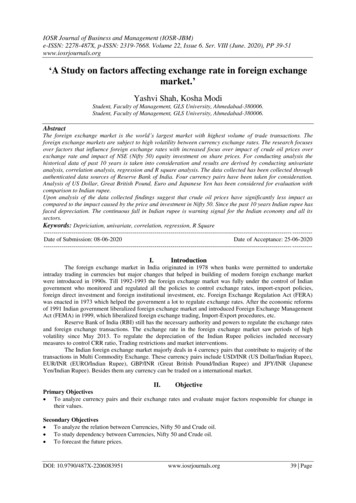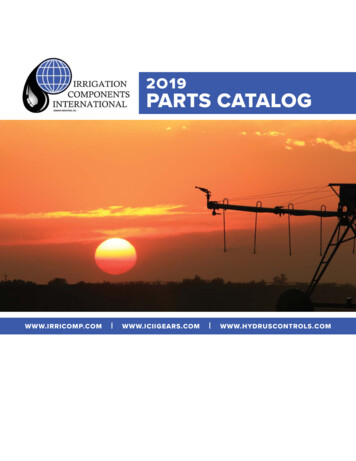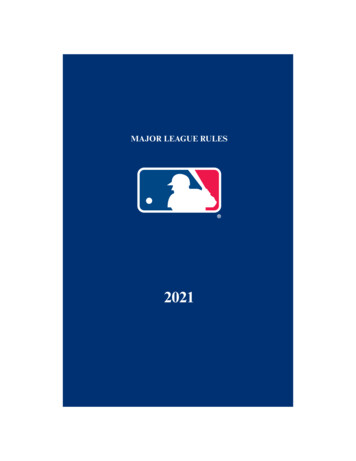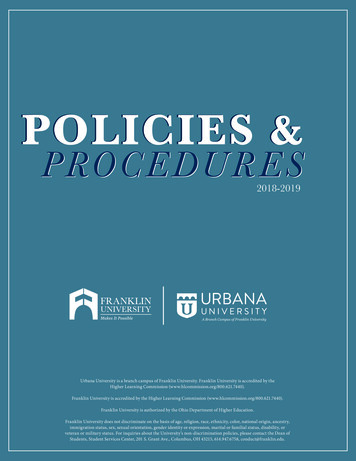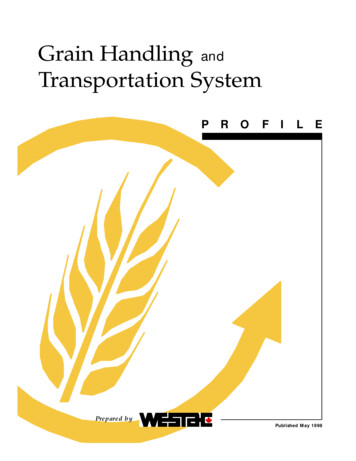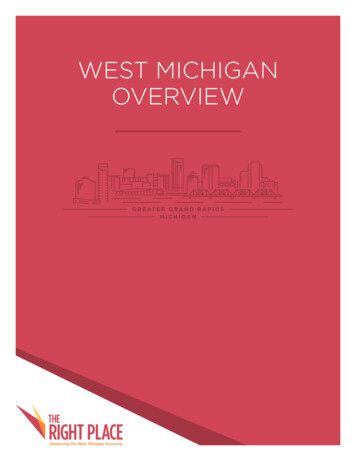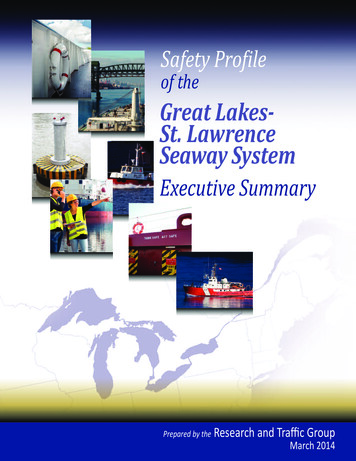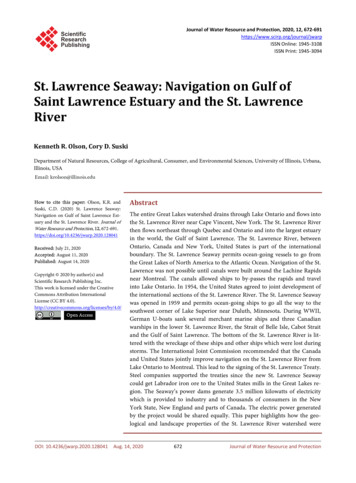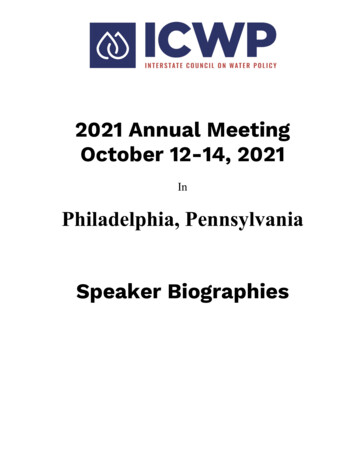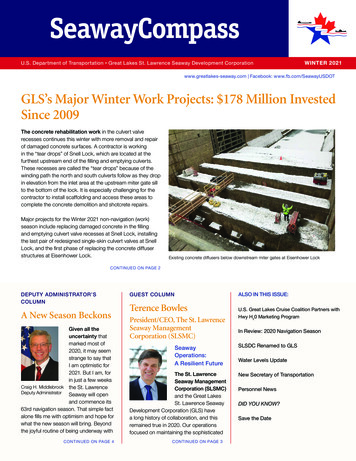
Transcription
SeawayCompassU.S. Department of Transportation Great Lakes St. Lawrence Seaway Development CorporationWINTER 2021www.greatlakes-seaway.com Facebook: www.fb.com/SeawayUSDOTGLS’s Major Winter Work Projects: 178 Million InvestedSince 2009The concrete rehabilitation work in the culvert valverecesses continues this winter with more removal and repairof damaged concrete surfaces. A contractor is workingin the “tear drops” of Snell Lock, which are located at thefurthest upstream end of the filling and emptying culverts.These recesses are called the “tear drops” because of thewinding path the north and south culverts follow as they dropin elevation from the inlet area at the upstream miter gate sillto the bottom of the lock. It is especially challenging for thecontractor to install scaffolding and access these areas tocomplete the concrete demolition and shotcrete repairs.Major projects for the Winter 2021 non-navigation (work)season include replacing damaged concrete in the fillingand emptying culvert valve recesses at Snell Lock, installingthe last pair of redesigned single-skin culvert valves at SnellLock, and the first phase of replacing the concrete diffuserstructures at Eisenhower Lock.Existing concrete diffusers below downstream miter gates at Eisenhower LockCONTINUED ON PAGE 2DEPUTY ADMINISTRATOR’SCOLUMNA New Season BeckonsGiven all theuncertainty thatmarked most of2020, it may seemstrange to say thatI am optimistic for2021. But I am, forin just a few weeksCraig H. Middlebrook the St. LawrenceDeputy AdministratorSeaway will openand commence its63rd navigation season. That simple factalone fills me with optimism and hope forwhat the new season will bring. Beyondthe joyful routine of being underway withCONTINUED ON PAGE 4GUEST COLUMNALSO IN THIS ISSUE:Terence BowlesU.S. Great Lakes Cruise Coalition Partners withPresident/CEO, The St. LawrenceSeaway ManagementCorporation (SLSMC)SeawayOperations:A Resilient FutureThe St. LawrenceSeaway ManagementCorporation (SLSMC)and the Great LakesSt. Lawrence SeawayDevelopment Corporation (GLS) havea long history of collaboration, and thisremained true in 2020. Our operationsfocused on maintaining the sophisticatedCONTINUED ON PAGE 3Hwy H20 Marketing ProgramIn Review: 2020 Navigation SeasonSLSDC Renamed to GLSWater Levels UpdateNew Secretary of TransportationPersonnel NewsDID YOU KNOW?Save the Date
GLS’S MAJOR WINTER WORK PROJECTS: 178 MILLION INVESTED SINCE 2009CONTINUED FROM PAGE 1The first of two phases to replace threeof the six concrete diffuser structures atEisenhower Lock is also underway. Thediffusers have deteriorated since theiroriginal construction over 60 years ago,and they play a critical role in the operation of the lock. When the lock is loweredto allow a vessel to transit from upstreamto downstream, approximately 22 milliongallons of water are released from thelock in about seven minutes. Thediffusers control this massive release ofwater as the velocity of the flow is significantly reduced while passing through thediffusers before entering the downstreamwaterway. The diffusers at Snell Lock willalso be replaced in the next few yearsafter the work at Eisenhower Lock hasbeen completed.View from below an inlet to the “tear drop” areas ofthe recessed culverts at Snell LockView of surface to be repaired with shotcrete in therecessed culverts at Snell LockFinishing demolition of first phase diffusers atEisenhower LockLifting new precast concrete diffuser “cap” intoplace at Eisenhower LockAbout ten years have passed since theprototype single-skinned culvert valveswere installed at the upstream end ofSnell Lock. The upstream and downstream pairs of culvert valves controlthe flow of water into and out of the lockthrough the 14 feet wide by 14 feet tallrecessed culverts that run the length ofthe lock. These prototype valves wereproven successful, and two other pairsof the redesigned valves have beeninstalled at Eisenhower Lock. The finalpair of the original double-skinned culvertvalves will be replaced this year at thedownstream end of Snell Lock.Final pair of redesigned single-skin culvert valves being installed at downstream end of Snell Lock2SeawayCompass Winter 2021
GUEST COLUMNIST TERENCE BOWLESCONTINUED FROM PAGE 1assets and technologically-advancedsystems of the Seaway and providingsafe and secure transits for vessels usingthe waterway to move goods to and fromNorth America.Just as we were getting ready to openthe 2020 navigation season, we becameaware of the seriousness of the pandemic.Quickly, we started working with keyCanadian and U.S. stakeholders andmarine industry associations to implementprotocols to ensure the transportationcorridor continued to be safe, secureand efficient. The measures taken weresuccessful, and the Seaway was ableto maintain a high level of operationalperformance, while remaining a responsive transportation system and vital tradegateway. Nearly 38 million tonnes of cargotransited the system in 2020, which weare pleased with, considering the globaleconomic impact from numerous lockdowns in countries around the world.Resilient maritime transportation systemsaround the world are key to the efficientfunctioning of the global economy. Inaddition, marine shipping is the mostenergy-efficient transportation mode,with the lowest carbon footprint and,of course, during the pandemic it hasproven to be one of the safest and mostreliable modes of transportation.While Lake Ontario water levels in 2020were well below those experienced in2017 and 2019, water outflows remainedan important concern for our twoCorporations. We have worked collaboratively with key stakeholders to managewater flows and to ensure vessels cansafely transit the system, while minimizingthe risk of flooding to communities.Through a combination of favorableweather and constant efforts to optimizewater outflows, as of February, waterlevels in Lake Ontario are below historicalaverages, which is very encouraging.Operationally, 2020 was a strong year forthe Seaway Management Corporation.Safety results were world class, withboth our lost time incident and totalincident rates at 0.31 incidents per2000 hours worked. During the navigation season, even with the pandemic,we continued to provide reliable andefficient service to our customers.There were few vessel delays relatedto Seaway operations and the weathercooperated at the end of the year, whichresulted in a smooth close to navigation.With a less severe winter, winter worksprojects have gone well. By the end of2020/21, we will have completed variousmajor investments under our AssetRenewal Plan, including bridge and lockprojects, to ensure continued systemavailability of 99.5 percent.Along with our work at maintaining arobust transportation route, we continuesupporting initiatives such as all-seasonbuoys, increased ice-breaking assetsand pilotage efficiencies, which assist inseason extensions.We are now preparing for our 2021navigation season. As noted, the lack ofice this winter has kept the winter worksprojects on schedule. This combinedwith strong demand, especially for themovement of grain, has allowed us toannounce a normal opening date of lateMarch. Our opening ceremony, thoughby necessity mostly held remotely, willbe an occasion to highlight both thecritical role the Seaway Corporations andmarine transportation have played in theeconomies of our countries, especiallyduring the pandemic, and to recognizethe strength of the U.S./Canada relationshipexemplified by the joint management ofthe Seaway.We are optimistic that the globaleconomy will improve in 2021, althoughsome of this is dependent on how thepandemic and vaccines are managed.The movement of goods will remaincentral to any improved economicactivity, and we are ready to support themarine industry in any way we can.www.greatlakes-seaway.com Facebook: www.fb.com/SeawayUSDOT3
DEPUT Y ADMINISTRATOR’S COLUMNCONTINUED FROM PAGE 1Over the last 25 years, the averagenumber of vessel incidents in the Seawayhas decreased significantly. Since 1996,the average number of incidents hasdeclined from 19 per year (1996–2006)to only six per year (2007–2020). Lastyear’s total of four vessel incidents wasthe second lowest on record (achievedpreviously in 2017 and 2011), and thisdownward trend bodes well for theupcoming navigation season.GREAT LAKES ST. LAWRENCE SEAWAY DEVELOPMENT CORPORATION (GLS)another navigation season, however, Iam optimistic because there are so manyindicators and trends that are pointing ina favorable direction where the Seawayis concerned. Take safety, for example.The Seaway remains one of the safestwaterways in the world, and as this chartshows, we are coming off one of thesafest navigation seasons on record.Water levels is another cause for optimism.Last year’s navigation season openingwas affected by the effects of highwater levels on Lake Ontario. This year,however, is a very different—and muchmore positive story. Throughout the LakeOntario/St. Lawrence River basin, precipitation and water levels have returned toCONTINUED ON PAGE 5INTERNATIONAL LAKE ONTARIO-ST. LAWRENCE RIVER BOARD (ILOSLRB)4SeawayCompass Winter 20214
DEPUT Y ADMINISTRATOR’S COLUMNCONTINUED FROM PAGE 4GHG Emissions Comparisons (2010 vs Post Renewal)Combined Great Lakes-Seaway FleetThose of us who have worked in andaround Great Lakes Seaway shippinghave known for a long time that maritimenavigation is one of the most—and inmany cases the most—environmentallyfriendly modes of transportation by variousmeasures. According to the most recentstudy on the subject (Environmental andSocial Impacts of Marine Transport inthe Great Lakes-St. Lawrence SeawayRegion, 2013), Great Lakes Seawaycommercial navigation carrying one tonof cargo one kilometer emits 19 percentfewer greenhouse gases than rail and533 percent fewer greenhouse gases thantrucks. This fact may finally get the widerrecognition it deserves as the role of maritime transportation in mitigating climatechange starts to garner more attention inthe U.S. and Canada.RESEARCH AND TRAFFIC GROUP (RTG)more normal levels. As of this writing, LakeOntario water levels are down 58 cm (23inches) from last year’s levels at this time,and 14 cm (5.5 inches) below average forthis time year. The forecast going into theseason is for average to below-averageprecipitation and water levels, whichbodes well for all concerned, includingcommercial navigation.Finally, after a very strong end to the2020 navigation season in terms ofoverall cargo, there is reason to beoptimistic that the 2021 season willbegin where the 2020 season left off. Aseconomies around the world improvewith each passing month, this positive trend is good news for the manycargoes shipped through the Seaway.Every navigation season is different, ofcourse, and each is marked by its owndistinctive ups and downs. The 2021season will be no different. Nevertheless,I remain optimistic because this seasonstarts out from a position of strength:improving navigation safety, stable waterlevels, a growing recognition of maritimenavigation’s environmental benefits, anda steadily improving economic situationin North America and elsewhere. Lastyear reminded all of us of the need to becautious in the face of a very uncertainworld. That is still true, but as the worldthis year seems to offer us a little morecertainty, I’m optimistic that better daysare ahead!U.S. Great Lakes Cruise Coalition Partners with Hwy H20 Marketing ProgramThe United States-based members of the U.S. Great Lakes Cruise Coalition (GLCC), which consists of variousU.S.-based ports, vessel agencies, and tourism entities, have now joined the Hwy H2O marketing brand ofthe Great Lakes St. Lawrence Seaway System (GLSLS). This move aligns regional cruising advocates with anexisting brand that markets the Seaway System to users, including cargo owners, vessel lines, and other stakeholders of the system. This also brings marketing opportunities for cargo and cruising under one organization.The Great Lakes Cruise Coalition, which includes members in both the United States and Canada, was createdas a bi-national membership organization approximately 20 years ago with the specific goal of enticing cruiselines into the GLSLS market. While that goal has been realized, ongoing marketing efforts are necessary tocontinue expanding cruising in the Great Lakes Seaway System.Under the new structure, cruise lines interested in calling on the GLSLS, should contact Rebecca Yackley,Director, Trade and Economic Development, Great Lakes St. Lawrence Seaway Development Corporation(202) 366-5418. Media inquiries should be directed to Nancy Alcalde, Director of Congressional and PublicRelations, Great Lakes St. Lawrence Seaway Development Corporation (202) 366-6114.www.greatlakes-seaway.com Facebook: www.fb.com/SeawayUSDOT5
In Review: 2020 Navigation Season2020 was a navigation season thattested the St. Lawrence Seaway inunimagined ways and, despite thechallenges presented, the Seaway keptcommerce moving while maintaining itstraditionally high standards for safetyand reliability.In total, 37,736,000 million tons ofcommodities moved through theSeaway, reflecting a 1.66 percentdecrease in Seaway-wide total tonnagecompared to the 2019 navigationseason. Remarkably, this volumekept pace with the Seaway’s five-yearaverage, a testament to the resiliency ofthe system in unprecedented times.There were several cargo categories thatsurged in 2020. These areas of strengthhelped offset some traditionally strongcargo sectors that were impacted; thecomplete shutdown of the automotiveindustry, the steel supply chain’s closureof ore mines; the idling of Great Lakesblast furnaces; and the manufacturingsector’s reduced demand for international steel to compliment the affecteddomestic production.Those top-performing cargosthroughout the 2020 NavigationSeason included: G rain — 13,308,000 metric tons;27.1%* increase G eneral Cargo — 2,264,000 metrictons; 3.3%* increase (Includes WindEnergy Cargo) G ypsum — 859,000 metric tons;32.8%* increase Coal — 2,439,000 metric tons; 2.0%*increase A sphalt — 372,000 metric tons;30.9%* increase*Percentages rounded to nearest tenthGrain: A Record Setting Year forCanada & A Rebound U.S. HarvestGrainThe season opened with a rush ofvessels entering the system to load grainin Thunder Bay, Duluth, and Toledo, apattern that was maintained throughoutthe year. When the record Canadianharvest and strong U.S. crop went to thelocal port elevators in the Fall of 2019,the load centers of Milwaukee, Chicago,Burns Harbor, Windsor, and HamiltonOshawa added their share of vesselsladen with agricultural exports right upuntil the close of the season.In a year when many supply chains weretested and over-burdened, the GreatLakes St. Lawrence Seaway Systemmaintained its role as a dependable foodsupply chain sending soy, wheat, corn,and other grains to global markets. BothU.S. and Canadian grain export tonnageincreased by 27 percent over 2019levels, and given the record Canadianharvest and a rebounding U.S. crop, the2021 navigation season will start off in astrong position.Wind Energy Cargo Across theSystem & Back to Back RecordYears at Port of DuluthIt was not just grain exports that movedat a frenetic pace during the 2020navigation season. The Great LakesSt. Lawrence Seaway System built uponthe momentum of recent navigationseasons to further expand its role as arenewable energy supply chain, deliveringwind energy equipment for projectsthroughout North America’s heartlandand extending west into Canada and theplains states of America.Leading the way once again was ThePort of Duluth-Superior. The Port setanother new record for the volume ofwind-energy cargo handled at the ClurePublic Marine Terminal, managed byDuluth Cargo Connect. After settinga record in 2019 of 306,000 freighttons of wind energy cargo, their 2020volume grew to 525,000 freight tons. Inaccomplishing back-to-back milestones,shipments arrived on 30 Seaway vesselsand originated from eight countries:Brazil, Germany, India, Malaysia, Mexico,South Korea, Spain, and Turkey. Includedin their record tonnage were the largestwind blades and towers ever to behandled at the port.Windmill bladesAll totaled during the 2020 navigationseason, 92 ocean vessels transited theSt. Lawrence Seaway laden with windenergy cargo heading to eight U.S. portswithin the system. The Great LakesSt. Lawrence Seaway System routinelydemonstrated its value as a global supplychain for renewable energy projectsthroughout North America from 14countries of origin: Germany, Denmark,Spain, France, Turkey, Mexico, Brazil,and the Netherlands as well as India,China, South Korea, Thailand, Malaysia,and Vietnam.CONTINUED ON PAGE 76SeawayCompass Winter 2021
IN REVIEW: 2020 NAVIGATION SEASONCONTINUED FROM PAGE 6With some traditional Seaway cargos,and their corresponding ports, severelyimpacted in 2020, the volume and distribution of the wind energy cargo throughoutthe system provided critical revenue andemployment. Several ports had their2020 Seaway tonnage revolve exclusivelyaround wind energy cargo including Erie,PA, where the very first wind cargo vesselof the season arrived within a week of theSeaway opening in April.The Port ofMonroe, MIoperated a shortsea shippingschedule for windenergy cargowith the Port ofBecancour that resulted in 16 port callsduring the season. Bay City, MI handledwind cargo from China and South Koreafor projects in Michigan and Indiana onan even larger scale than in 2019 witha dozen vessels bringing in equipment.The Port of Ogdensburg, NY receivedfive wind energy vessels from China andSpain for a wind farm project located inupstate New York. And Menominee, MIcontinued its support of wind projectsin the upper Midwest by handlingwind cargo early in the season. Thoseshipments originated from Morocco,Denmark, and Spain.Ports HighlightsThe Port of Burns Harbor in Indianacelebrated its 50th anniversary during anavigation season in which their tonnagewas highlighted by several large-scaleproject cargo shipments. In addition toreceiving wind energy equipment fromMexico and India for two large windfarm projects in Ohio and Indiana, thePort handled cargo for one of the largestshipments in port history. Over 600 piecesof cargo arrived on board ten Seawayvessels carrying power generation equipment for the 1 billion Indeck Niles EnergyCenter under construction in Michigan.The port also handled some Europeansteel (though at a reduced level), as wellas coke from Italy and coal from Poland.They, too, participated in the strong grainexport lane loading vessels with shipmentsbound for England, Spain, and Greece.soybeans included Spain, Gibraltar,the Azores, Egypt, Belgium, and TheNetherlands. Further, their General Cargotonnage increased by 13 percent. In all,they had a total of 55 overseas vesselsthrough the port, an increase of sevenfrom 2019. Cargo handled at the portincluded aluminum from Canada, fertilizer from Norway, pig iron from Russiaand Ukraine, sugar from Morocco, alfalfafrom France, cement from Turkey, andsalt from Egypt. Coke was exportedto Canada, The Netherlands, Spain,Gibraltar, and Denmark.At the Port of Cleveland, one of theport’s cargo highlights in 2020 was thereceipt of 3,000 cubic meters of Austriantimber via Spliethoff’s Cleveland-EuropeExpress in November. It will be assembled later this year in the construction ofthe country’s largest all-wood structure,a nine-story, 115-foot high residentialhousing complex located near downtownCleveland. Additionally, the Spliethoffscheduled service brought in its mixtureof containerized goods and breakbulk(including some expensive yachts) whilethe Port also received vessels throughoutthe season via Fednav’s FALLINE LinerService carrying steel and breakbulkfrom Europe.The Port of Lorain’s Seaway trafficconsisted of several export vesselsladen with coke headed to Mexico aswell as inbound salt from the lowerSt. Lawrence.One of thebeneficiariesof the strongasphalt seasonwas the Portof Detroit withseveral shipments during the season. Detroit alsohandled several shipments of steel fromEurope, heavy equipment from Chinaand Vietnam, and gypsum.The Port of Toledo’s season was representative of the System’s performanceas a whole, with over 1.5 million tonsof grain loaded at its waterfront terminals, representing a five-year high andan increase of 55 percent over 2019.Destinations for the exported corn andThe State ofNew York’s portswere diversein the cargothey handled.In addition tothe wind cargoin Ogdensburg, the Port of Oswegohandled several aluminum shipments forCONTINUED ON PAGE 8www.greatlakes-seaway.com Facebook: www.fb.com/SeawayUSDOT7
SLSDC Renamed to GLSThe SLSDC has officially been renamed. The 2020 Water Resources Development Act (WRDA), signed into law on December 27, 2020,as part of the stimulus and FY 2021 federal appropriations package, included language to rename the SLSDC as the “Great LakesSt. Lawrence Seaway Development Corporation” (GLS).The name change was spearheaded in Congress by Ohio members Rep. Marcy Kaptur and Sen. Sherrod Brown to better reflect theregional focus of the agency and its important role in sustaining economic development and commerce. In the coming months, you willbe seeing the name change reflected in a number of ways including a new logo, new letterhead, and new signage for the agency.The Port ofChicago, IL wasdiverse in itsSeaway cargomix, receivingtwo wind cargovessels fromDenmark carrying hubs while continuingto receive vessels carrying breakbulkcommodities like steel, lumber fromGermany, and cement from Turkey. Onthe export side, there were two tug/barge movements of mud oil and petroleum to the Port of Baltimore, bunkeroil to the Lower St. Lawrence, andsoybeans to Ireland and Norway.IN REVIEW: 2020 NAVIGATION SEASONCONTINUED FROM PAGE 7a local manufacturer whose operationswere impacted early in the season. ThePort of Buffalo, NY received multiplevessels of wind energy cargo from Spain,South Korea, and Germany with equipment destined for wind farm installationwithin a few hours of the port in upstateNew York. Buffalo also handled severalvessels of organic sugar from Argentina. AIDAN VOGT, MARINETRAFFIC.COMPort of Buffalo8SeawayCompass Winter 2021Looking atWisconsin’s navigation season, there wascritical cargo deliveredto the Port of GreenBay. In order to meetspiraling demand, thePort received multiple shipments of woodpulp from Brazil for the Wisconsin paperindustry to be used in hard-to-find productslike toilet paper and sanitary wipes.The Port of Milwaukee saw a steady flowof steel including tinplate material usedby manufacturers in the region’s foodand beverage industry, machinery andbrewery tanks from Belgium. Once theFall harvest arrived at the port, sevenvessels exported soybeans to destinations throughout Europe, North Africa,and the Middle East.When reviewing the 2020 Navigationseason, most importantly, the bi-nationalGreat Lakes St. Lawrence Seaway keptthe “lights on and vessel traffic moving”from opening day to closing day, safelyand efficiently. As a critically importantglobal supply chain, 2020’s GreatLakes St. Lawrence Seaway performancewas, in the end, “business as usual”.And it couldn’t have come at a bettertime.
Water Levels UpdateSTEVE RUSSELL, GETTY IMAGESCaution signs at Queens Quay Terminal as thehigh water levels in Lake Ontario leave portions ofToronto’s waterfront flooded on May 31, 2019.During the 2019 navigation season,water levels on Lake Ontario were atrecord highs. High Lake Ontario waterlevels continued to impact the beginning of the 2020 navigation season aswell, as the International Lake OntarioSt. Lawrence River Board (ILOSLRB)permitted record outflows in January,February, and March to reduce the riskof flooding on Lake Ontario.The Seaway Corporations voluntarilydecided to adjust the opening datefor 2020, pushing it back to April 1, toaccommodate this successful effort.It is important to note that underthe 1909 Boundary Waters Treatybetween Canada and the U.S., and thesubsequent water use plans adoptedpursuant to the 1909 Treaty, includingthe latest plan (Plan 2014), the SeawayCorporations were not required to delaythe opening date to accommodatehigher outflows. Under the 1909 Treaty,commercial navigation uses are anexplicitly recognized priority use for theshared waters between Canada andthe United States. Under Article VIII ofthe 1909 Treaty, navigation is secondonly to domestic and sanitary uses.Nevertheless, in 2020, the SeawayCorporations worked closely with theILOSLRB to maximize outflows whileensuring safe conditions for navigation.Ontario levels are about 10 cm below thehistorical average and down nearly 58 cmfrom the previous year—that is almosttwo feet lower than 12 months ago. As aresult, the projection is for more normalopening conditions, and the SeawayCorporations announced a March 22opening date for the Montreal-to-LakeOntario section of the Seaway. TheMarch 22 date is consistent with pastSeaway opening dates.The situation this year, fortunately, ismuch different—and much improved—aswater levels have stabilized considerablyand reverted back to historical averages.Precipitation over the winter has beenslightly lower than average, and theILOSLRB has done an excellent job ofmaximizing outflows during the time thatthe Seaway has been closed for wintermaintenance. As of this writing, LakeWater levels are most heavily influencedby natural factors, including rain, evaporation, winds and runoff from streamsthat feed into the St. Lawrence River. Asnapshot from February 21, 2021 illustrateshow water levels change from year toyear. The water level in Lake Ontario hasremained relatively constant in the sametime period, hovering around the historical average level.Stats periods of record: 1918–2019. Historical statistics and comparisons to previous years are for referencepurposes only, based on quarter-monthly data‡ and do not reflect fluctuations seen in daily data.www.greatlakes-seaway.com Facebook: www.fb.com/SeawayUSDOT9
New Secretary of TransportationOn February 2,Pete Buttigieg,former mayorof South Bend,Indiana, wasconfirmed by theU.S. Senate asthe new Secretary of Transportation.The final vote of 86 to 13 was seen asa strong show of support for the newSecretary. He was sworn in to assumehis new position by Vice PresidentKamala Harris on February 3. At 39, heis the youngest Transportation Secretaryin the Department’s history.At his confirmation hearing beforethe Senate Commerce, Science, andTransportation Committee on January 21,he outlined a number of his primary goals.In addition to an immediate focus onsafety, he indicated that one of his prioritieswill be investment in transportationinfrastructure, a positive signal forthe Great Lakes Seaway System ascontinued capital investment in U.S.ports, Seaway locks, and other maritimeinfrastructure is critical to the mission ofthe Great Lakes St. Lawrence SeawayDevelopment Corporation (GLS).In his first few days at the Department,he urged all 55,000 DOT employeesto embrace “ imaginative, bold,forward thinking, as the TransportationDepartment embarks on a vital mission torebuild America’s infrastructure and fosterequality.” He said he is “deeply optimistic”about the transportation industry, despitethe damage caused by the pandemic,saying that the mission of the USDOT“ has never been more important thanin this season of change and possibility.”Secretary Buttigieg hosted his firstlistening session at the Department withthe GLS workforce. A number of GLSemployees described their jobs andalso their challenges at the Seaway.Afterwards, the Secretary noted howmuch he enjoyed the session andlearning about the important work thatGLS employees do every day, sensingthe level of commitment, the quality,and the caliber of the Seaway team.He appreciated hearing about personalstories ranging from childhood memories of visiting the locks to an inspiringcommitment to family and community lifewhen not at work. He also reflected thatalthough the GLS is the smallest modeat the Department, he finds it one of themost fascinating in terms of the workthe agency does. On behalf of the GreatLakes Seaway System and its stakeholders, the GLS welcomes SecretaryButtigieg and looks forward to accomplishing many positive things together inthe years ahead.Personnel NewsIn January, Ian Hirtannounced that hewould return to theprivate sector afterfour years as portdirector of Ports ofIndiana-Burns Harbor.“It has been an honorto lead the northwest Indiana port thathas an impressive 50-year history,” saidHirt. “It truly has been a pleasure to workwith an outstanding executive leadershipteam, staff, tenants, commission andcommunity partners.” R eceived 2019 South Shore CleanCities Sustainability Leadership Awardfor its work to reduce diesel emissionsthroughout the port;During Hirt’s tenure, the northwestIndiana port achieved the following: E xtended its partnership with FederalMarine Terminals, a nationallyrenowned stevedore company. I mplemented numerous environmentalinitiatives including the adoption of itsown stormwater management programauthorized by the Indiana Departmentof Environmental Management;10SeawayCompass Winter 2021 R eceived 2019 Northwest IndianaPartners for Clean Air Industrial Awardfor its work to improve air quality innorthwest Indiana; C ompleted an exceptional year ofhandling heavy-lift cargo in 2020,including cargo for a 1 billion powerplant, one of the largest shipments inits 50-year history; A dditionally, Ports of Indiana-BurnsHarbor hosted Indiana’s first U.S. Navyvessel commissioning ceremony forUSS Indianapolis.“We are grateful for Ian’s professionalleadership and dedication to help growIndiana’s economy through notableproject cargo shipments, environmentalstewardship and partnership opportunities throughout the northwest Indianaport,” said Vanta E. Coda II, CEO of Portsof Indiana. “As we work through thistransi
RESEARCH AND TRAFFIC GROUP (RTG) GHG Emissions Comparisons (2010 vs Post Renewal) Combined Great Lakes-Seaway Fleet. U.S. Great Lakes Cruise Coalition Partners with Hwy H 2 0 Marketing Program The United States-based members of the U.S. Great Lakes Cruise Coalition (GLCC), which consists of various

